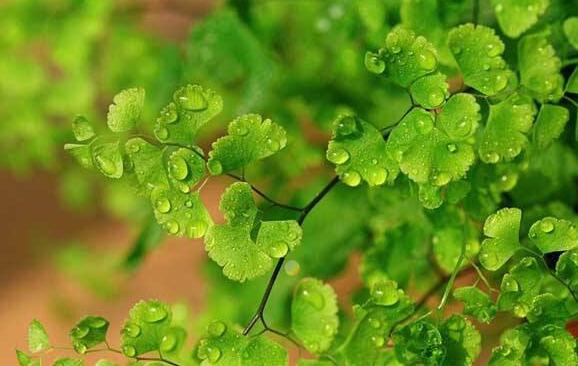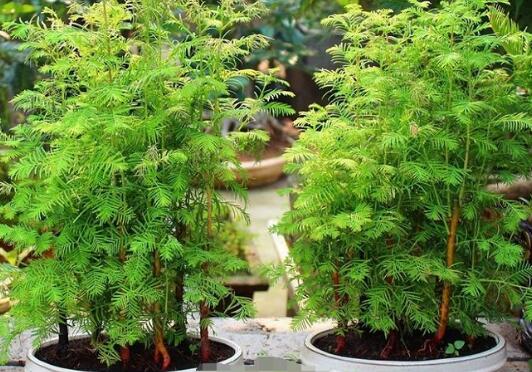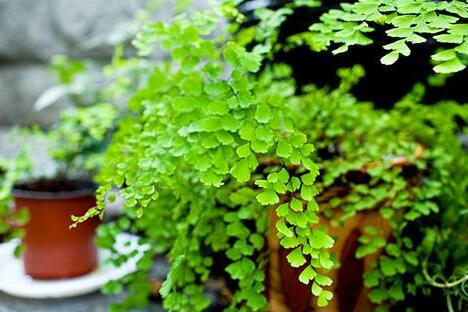What to do about the withered leaves of Dryopteris przewalskii? six ways to improve the wilt phenomenon / pay attention to maintenance and management
Dryopteris is a perennial evergreen herb. if the environment is suitable and the conservation skills are correct, its leaves should be green and shiny, but sometimes it will encounter leaf withering for a variety of reasons, which is a great headache. What about the withered leaves of Dryopteris? Now let's analyze the main reasons and the corresponding solutions.
What about the withered leaves of Dryopteris?

1. Serious water shortage
Reason: botanists tell us that Dryopteris is a plant that likes a wet environment, especially for water, so it is recommended to water once a day during the growing period, if it is often not watered or watered through, the leaves will wither due to serious lack of water.
Method: there are two principles in watering: the first principle is that the soil is dry and wet, which means that the soil needs to be watered when it is dry, and stop watering when the soil is moist; the second principle is not to be short of water for a long time, set aside a few minutes every day to observe the wetness of the soil, and replenish water in time if it is too dry.
2. Plant frostbite
Reason: leaf wilting is easy to occur in winter, because the temperature is relatively low at this time, and the impact is small if the temperature is less than 5 degrees for a short time, but if you are often in a low temperature environment, the fern plants are easy to be frostbitten, causing water loss and withering.
Method: what about the withered leaves of Dryopteris caused by frostbite? The answer is to take good heat preservation measures before winter, the more common way is to move indoors, if you can make sure that the temperature can be maintained above 5 degrees, cover the periphery of the plant with plastic film, but you need to pay attention to maintain a certain degree of air permeability.
3. The light is too strong
Reason: Dryopteris is more afraid of direct light, especially the sun exposure. If you put it in the sun in summer, the leaves will wither and wilt in a very short period of time. This is because it is caused by the sun. It will first turn yellow and then gradually wither, which will affect its appearance.
Method: some flower friends keep Dryopteris outdoors in order to enjoy enough light, which is not a problem in itself, but it should be noted that 50% of the light should be shielded at noon and when the temperature is high, so as to avoid damaging the leaves due to too strong light.
4. The foliage is too dense
Reason: some flower lovers will find it strange that the breeding method of Dryopteris is correct and the environment is more suitable, but there are still a small number of leaves withering. What is the reason? In fact, if the growth is strong, it may also lead to wilting, because when the leaves are relatively dense, some of the outer branches and leaves will block the light, making the plants opaque, and some of the leaves that lack light will wither.
Method: the withering of leaves caused by this reason needs to be pruned at ordinary times, cut off some branches and leaves that are relatively dense, and retain some new and healthy branches and leaves, so that all parts of the plant can receive a certain amount of light. you can prevent some of the leaves from withering.
5. Air drying
Reason: when the air is relatively dry, the water contained in the leaves and branches of Dryopteris fern will be consumed too quickly, causing it to wither due to lack of water. This phenomenon is more common when it is kept indoors with heating or in unventilated and stuffy places in winter.
Method: pay attention to observe the humidity of the environment. If the air is relatively dry, you can increase the humidity by spraying water to Dryopteris. At the same time, it is necessary to avoid the environment being too stuffy and not ventilated, especially when you put on plastic film to keep warm in winter. Pay more attention to avoid being too closed and impermeable.
6. The soil is poor
Reason: when Dryopteris is planted for a period of time, the nutrients in the soil will be slowly absorbed. If it is left in a relatively barren soil for a long time, the leaves will wither due to lack of nutrients. This phenomenon usually occurs without changing the soil for more than 3 years.
Method: when selecting soil, try to compare fertile soil with more humus as the best, if the soil condition can generally add some organic fertilizer as base fertilizer, in addition, change the soil once every 1-2 years to avoid soil being too barren.
How to wither the leaves of Dryopteris Dryopteris? the treatment method of blackening the long spores on the back of the leaves of Dryopteris
Dryopteris Dryopteris is a kind of plant which likes temperature and is not tolerant to strong light, and it is distributed in many parts of our country. It is now a popular domestic plant, but if it is mismanaged during breeding, it can cause leaves to wither or blacken.
What about the withered leaves of Dryopteris?
1. When raising clematis, it is generally best to put them in places where the indoor light is relatively weak. However, in the more exuberant growth season, it is better to give sufficient scattered light.
2, pay attention to, in the daily maintenance process, the soil should be moisturized, so watering must be adequate. In dry weather, water should also be sprinkled on the leaves of Dryopteris to increase the humidity of the air.
3. If there is a blight, you can first control the water, or switch to hydroponic culture. In the usual maintenance, we should control the amount of watering, you can spray more water to maintain air humidity. For the dried leaves, it is best to cut them off.
Treatment of blackening of long spores on the back of Dryopteris leaves
The main results are as follows: 1. The reason of blackening: the plant grows slowly in winter and the nutrients of the leaves are insufficient. If the temperature is low and the leaves are frostbitten, the leaves will gradually blacken. The environment is shaded and impenetrable, and iron ferns like to be overcast. Many families will put it in the living room and bedroom for maintenance. It is inevitable that there is some poor ventilation. If the light is insufficient for a long time and the air is not convective, the leaves will turn black. Lack of fertilizer and water, Dryopteris likes fertilizer, if there is no fertilization for a long time, the wet potted soil will make the plant leaves wilt and gradually turn black.
2. Prevention and control methods: the temperature is low in winter, so it is easy to suffer frost injury. In addition, the light is weak in winter, many families will move the fern to the sunny balcony, but it is easy to freeze when the window is opened sooner or later. So control the indoor temperature, especially in the morning and evening, and don't put it by the window. Dryopteris does not like the muggy environment, especially in summer, which requires regular ventilation, increase air humidity and replenish light properly. Dryopteris prefers sandy loam rich in humus and needs plenty of fertility. Before planting, an appropriate amount of brick shavings or lime particles can be added to the soil to enhance calcium and improve soil permeability. In addition, fertilizing once a month in peacetime maintenance, focusing on calcium supplement.
The cause of the withering of the leaves of Dryopteris
1. The light is strong. Dryopteris itself is a plant that likes a semi-shady growing environment and is more afraid of direct sunlight. If the light is too strong, it will cause the water on the leaves to evaporate quickly and cause the leaves to wither.
2. Lack of water. Dryopteris likes to grow in a relatively humid environment. The soil should be kept moist and the air humidity should be kept at a high level when raising Dryopteris. If it is not watered enough, the water will be insufficient, which will often lead to the withering of the leaves of the fern.
3. Stagnant water. The leaves of Dryopteris will dry, and stagnant water is also an important factor. Because most plants do not like stagnant water, stagnant water will cause too many problems, such as rotten roots, yellowing leaves and so on. Although Dryopteris is a plant that likes a humid environment, if it is watered too much, it will be timely, causing the leaves to wither.
What about the scorched edge of the leaves of Dryopteris Dryopteris?
1. The leaves of Dryopteris Dryopteris have brown scorched edges, which is a common problem encountered in cultivation. Mainly because of improper maintenance environment, too strong sun, lack of water, the lack of water in the leaves will make some cells dry and dehydrated, the green will gradually fade, and then the focal edge will appear.
2. Immediately move the fern to the semi-shaded place for maintenance. If the fern is placed on the balcony, it is recommended to move the flowerpot to the bright place indoors, which will gradually ease in a few days. Take good care of it in the next few days and try to avoid being stimulated by bright light again. Cut off the charred leaves in time and spray water on and around the leaves to increase air humidity.
The withering or blackening of Dryopteris leaves is usually caused by fertilizer, water or temperature problems. You can carefully observe and find out the cause, and then solve the problem from the root. There are some specific solutions described above, which I hope will be helpful to you.
What are the reasons for the withering of Dryopteris leaves? What if the leaves of Dryopteris have withered?
Clematis, also known as pteridaceae, is a perennial herb of the genus Dryopteris of the family Pteridaceae, with strong adaptability and easy cultivation, suitable for indoor perennial potted plants, small potted plants can be placed on the desk and coffee table, larger potted plants can be used to decorate the windowsill, aisle or living room of the shady room, and they are also good leaf-cutting materials and dried flower materials. However, in the process of cultivating Dryopteris, its leaves are often found to wither. So, what are the reasons for the withering of Dryopteris leaves? What if the leaves of Dryopteris have withered? Let's take a look at it.
Dryopteris przewalskii
What are the reasons for the withering of Dryopteris leaves?
1. Soil discomfort
[reason] Dryopteris needs to change the basin every spring, like the loose, permeable and fertile calcareous sandy loam, pay attention to the choice of soil, if the soil is not suitable, it is easy to cause the leaves of Dryopteris to yellowing and falling.
[methods] Dryopteris likes calcium fertilizer, and a small amount of lime and broken eggshell can be added to the basin to add some calcium fertilizer.
Second, pruning discomfort
[reason] when withered leaves are found in the maintenance process, Dryopteris should be cut off in time to keep the plant fresh and beautiful and conducive to the germination of new leaves, otherwise too messy and crowded branches and leaves will lead to weak growth and yellowing of leaves.
[methods] when the clump of fern leaves is too dense, the old leaves can be pruned properly every autumn.
Third, insufficient watering
[reason] during the growth of Dryopteris, it is necessary to fully water and maintain high air humidity to keep the leaves dark green. If the water supply is insufficient or the air is dry, the leaves will turn yellow or curl scorched.
[methods] the branches and leaves of Dryopteris should be sprayed 2 or 3 times a day during the peak growing season.
The light is too strong
[reason] Dryopteris is a shade plant, such as strong light, it is easy to cause scorched leaf margin and yellow leaves.
[methods] the cultivation of Dryopteris should pay attention to shade outside, but it also needs to provide sufficient sunlight, and it is best to keep the flowerpot on the east or north windowsill of the room indoors.
5. Improper fertilization
[reason] improper watering and fertilization of Dryopteris will stain the leaves, resulting in the withering and yellowing of the leaves and affecting the ornamental effect.
[methods] the amount of fertilizer needed for Dryopteris is not much. It is generally possible to apply thin pancake fertilizer and water every 2 to 3 weeks, and the effect is better if a small amount of calcareous fertilizer can be added.
VI. Overwatering
[reason] Dryopteris likes the environment with high humidity, but if it is watered too much, it will also cause stagnant water, thus causing the leaves of Dryopteris to dry up.
[methods] Dryopteris should be maintained in accordance with the principle of less watering and more spraying. Dry places in the north can consider putting a plate under the basin with water to achieve the purpose of increasing air humidity.
Dryopteris przewalskii
Matters needing attention
1. Soil: Dryopteris likes loose, permeable and fertile calcareous sandy loam. when potted, the cultivated soil can be mixed with loam, rotten leaf soil and river sand.
2. Watering: clematis like a humid environment, and should be fully watered during the peak growing season. Besides keeping the basin soil moist, we should also pay attention to high air humidity.
3. Sunlight: Dryopteris likes bright scattered light, afraid of direct sunlight, the light is too strong, the leaves are yellow or even die, and the leaves can be properly shaded in summer. Direct light for a long time will cause most of the leaves to wither and yellow.
4. Temperature: Dryopteris likes to be warm and hardy, and the suitable temperature for growth is 21: 25 ℃ in daytime and 12: 15 ℃ at night. It should be cultured in greenhouse in winter.
5. Fertilization: rarefied liquid fertilizer is applied to Dryopteris Dryopteris 2 or 3 times a month, do not stain the leaf surface, so as not to cause rotten leaves, basin soil should add appropriate amount of lime and broken eggshell, reduce watering and stop fertilization in winter.
6. Insect pests: leaf blight often occurs in Dryopteris. Bordeaux solution can be used to control it at the initial stage, and 70% methyl topiramate 1000-1500 times solution can be used to control severe cases. If there is a scale insect damage, 40% omethoate 1000 times solution can be used for control.
7. Pruning: after the beginning of autumn, as the temperature drops, the fern enters a slow growth stage, and the old leaves will gradually turn yellow, so cut them off.
The above is about the causes of the withering leaves of the plant Dryopteris and the solutions. For those friends who grow Dryopteris at home, you can refer to the above method to solve the problem. The above content will be sorted out for you by the editor of the first Agricultural Economic Network. I hope it will be helpful to you.
- Prev

How to raise metasequoia bonsai, culture methods and precautions of metasequoia bonsai / avoid bright light
Metasequoia glyptostroboides is a highly ornamental plant, it can be potted or planted in a large area, but if you want to raise it well, there are many things you need to pay attention to. So how to grow metasequoia bonsai? What are the breeding methods and matters needing attention of metasequoia bonsai? Next, the editor will take you to learn about it.
- Next

Can Dryopteris Dryopteris be cultured in water? the culture methods of Dryopteris Dryopteris in water culture / three key points should be paid attention to.
Dryopteris prefers a humid environment, and it is also very suitable for keeping it indoors, so many people are considering hydroponics, but some flower lovers worry that hydroponics may cause root rot, so can Dryopteris be hydroponically cultured? The answer is yes. today, let's take a look at the hydroponic culture method of clematis.
Related
- Fuxing push coffee new agricultural production and marketing class: lack of small-scale processing plants
- Jujube rice field leisure farm deep ploughing Yilan for five years to create a space for organic food and play
- Nongyu Farm-A trial of organic papaya for brave women with advanced technology
- Four points for attention in the prevention and control of diseases and insect pests of edible fungi
- How to add nutrient solution to Edible Fungi
- Is there any good way to control edible fungus mites?
- Open Inoculation Technology of Edible Fungi
- Is there any clever way to use fertilizer for edible fungus in winter?
- What agents are used to kill the pathogens of edible fungi in the mushroom shed?
- Rapid drying of Edible Fungi

